-> My Collection; Magazine is not fully scanned, so no source album to see.
Various pieces of texts from an 1904 Annual edition of a Short Lived Weekly Magazine/Journal. Town text will also be found under the various towns mentioned;
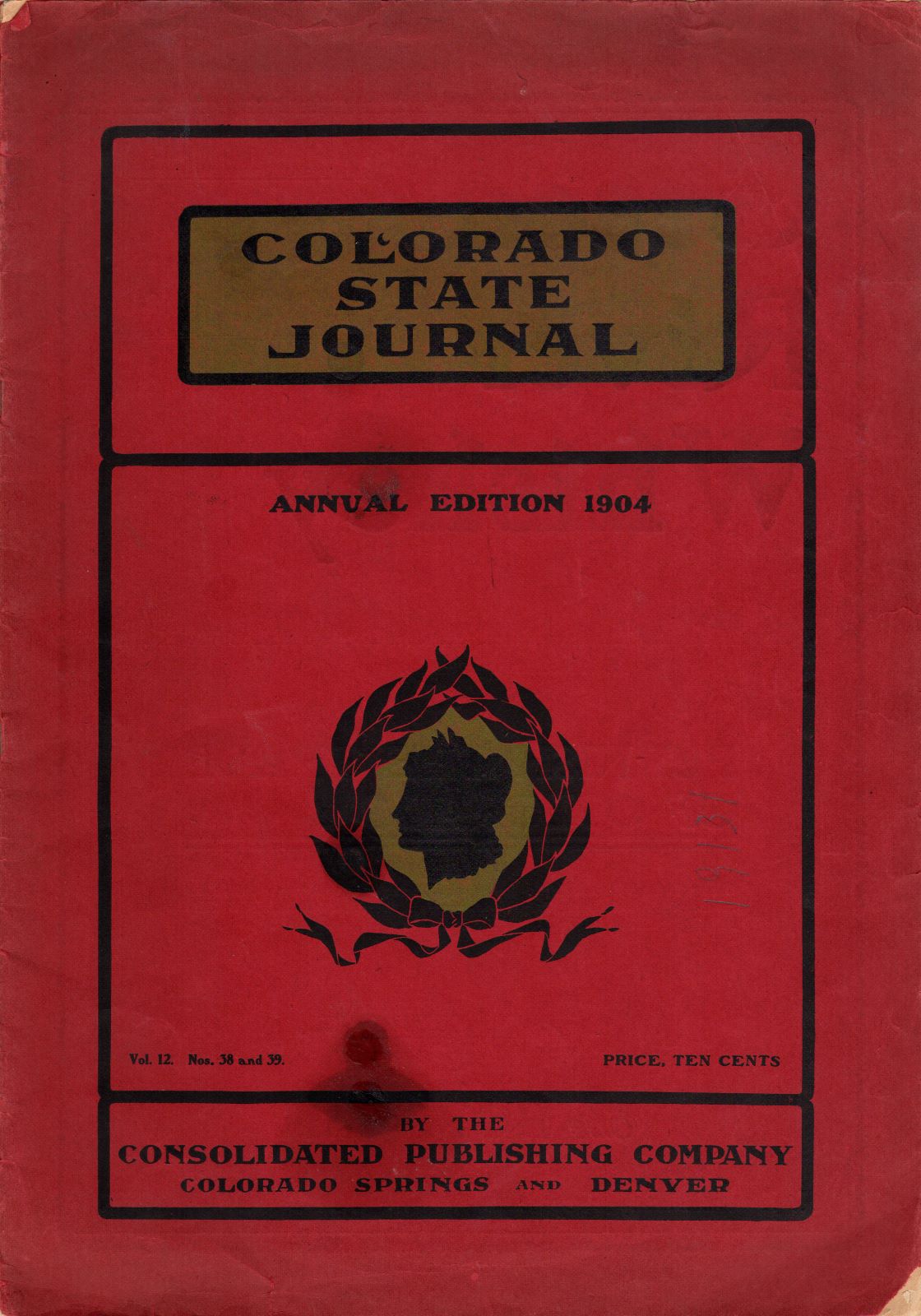 Front page
Front page
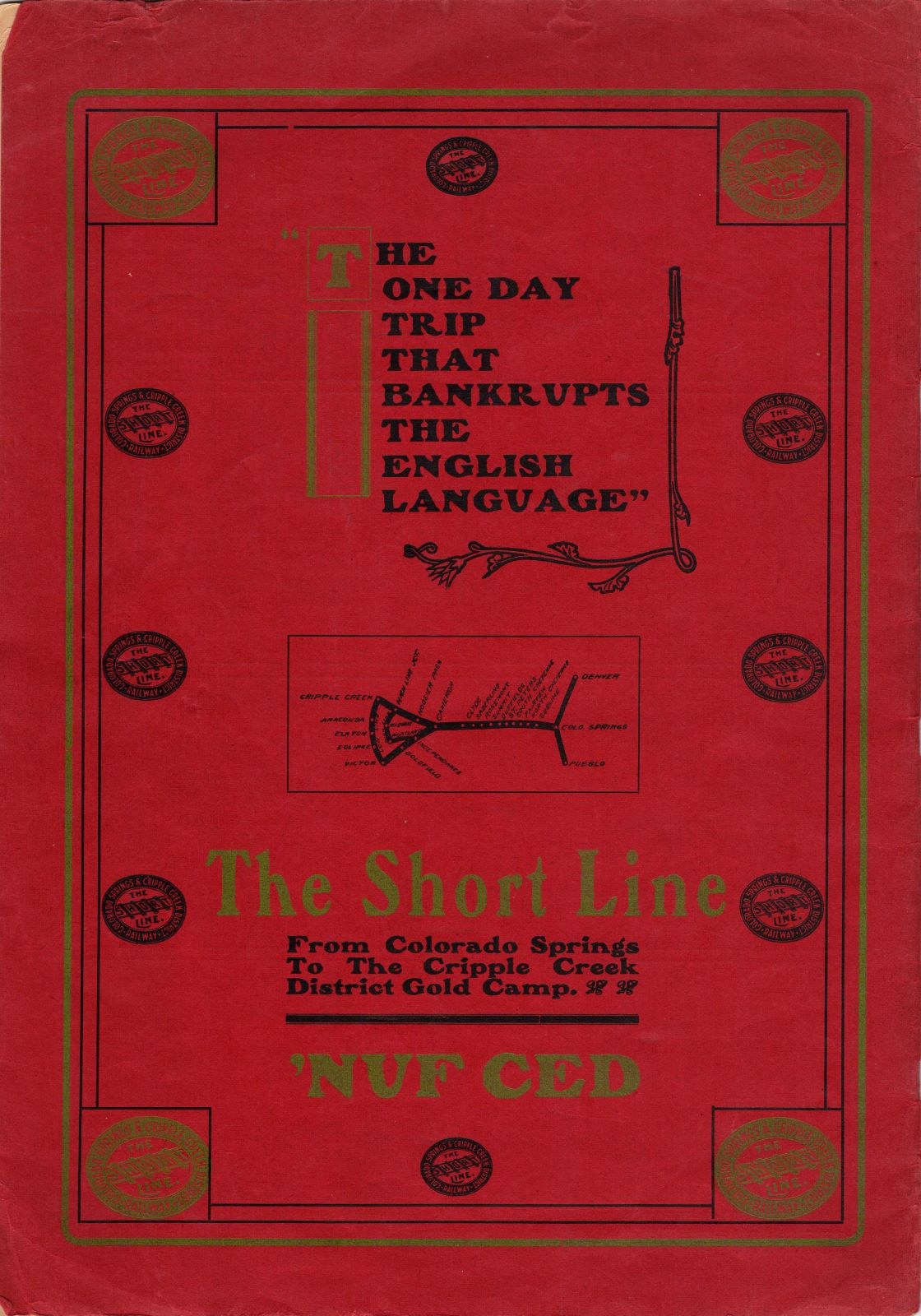 Back page, a full page
Back page, a full pagead for the Short Line.
(various pages, marked out below instead.)
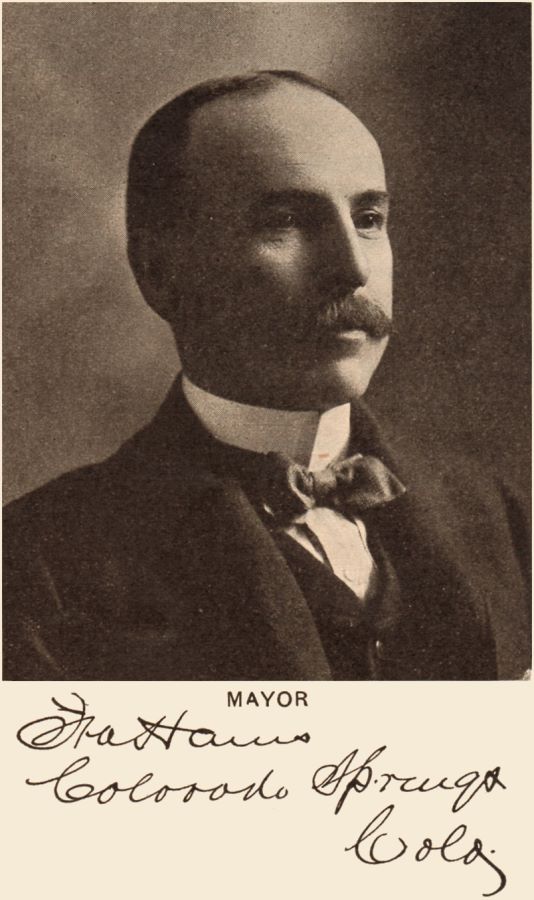 MAYOR |
"The air we breathe has never been used for that purpose before. Neither does it pass through factory flues, sewers, or foul alleys, nor is it used to sweep up the microbes of filthy streets, before we use it. We get it first. It is clean, thoroughly dried and fresh from the pines when it reaches us." "No snakes, no frogs, no eels, no bugs or turtles or other animalculae of any sort in our drinking water,—or beverages." " In one corner of our back yard is the Garden of the Gods, the only garden the gods have on earth." "No thick-necked, beetle browed, pug-nosed, double-fisted political bosses with dyed moustaches in either party here. We would hang such a person on sight." "More chronic growlers have been cured of that pestilential disease by the bracing atmosphere of Colorado Springs than the world dreams of." "There Pike's Peak stands a towering monument to the wisdom of those who came to Colorado Springs to live and get rich." |

Zebulon Pike
HERE we are with Mr. Pike's illustrious peak directly behind us, with clean, crisp mountain air within and about us, with the universe sailing through sunny skies above us, with the millions of the East fully a mile beneath us and with the whole world smiling pleasantly before us, and yet many of us seem afraid to admit it.
Here we are cuddled up close enough to the magnificent purple and lavender mountains to secure their protection from the weather from the west, and yet far enough away to secure an unobstructed view of their marvelous beauties. To the north, the Divide, that friendly rib of the Rockies with its picturesque highlands, is just close enough to look handsome and to turn any unpleasantness in the northern weather prairieward. To the south the fertile, sun-kissed valley of the Fountain Qui Bouille slopes gently and decorously to the Arkansas. Eastward the smiling prairie stretches and yawns for the husbandman and then rolls gracefully about its business toward the rising sun.
The two portals by which disagreeable weather may arrive are barred, the two by which warm, caressing breezes may enter are wide open. The character of our weather is therefore not only spotless, but stainless and above reproach the year round.
We have neither the bone-chilling damp of Chicago, with its blizzardy winters, its stifling summers, its gloomy mists, its foul, sooty air and its monotonous flat surroundings, nor yet the scorching heat, the salt pickled air, the fogs, fleas and fake orange groves of Southern California.
Of fogs, fleas, fevers, fakes, flim-flammers, et cetera, we know naught except what we read in the foreign papers.
The water we drink comes fresh from the sky-piercing, snow-capped Rockies, and is as pure and un-defiled as—as—the unborn babe. No snakes, no frogs, no eels, no bugs, no turtles or other animalculae of any sort in our water,—or other beverages.
The air we breathe has never been used for that purpose before. Neither does it pass through factory flues, sewers, or foul alleys, nor is it used to sweep up the microbes of filthy streets before we use it. We get it first. It is clean, thoroughly dried and fresh from the pines when it reaches the 25,000 lucky moderns who live in this magic city.
Gnats, mosquitoes, street pianos, clanging church bells, yawping fakirs, chiggers and other like pests are all unknown up here.
Tuberculosis, asthma and malaria microbes cannot live, at this altitude. The air is so thin that they chase themselves to death trying to catch their breath.
One of our prominent ex-consumptives weighs 225 pounds, and tames bucking bronchos for amusement and exercise only. Our last asthmatic from the East climbs a rope every morning before breakfast and is the best runner in the hose company.
We have many things to be proud of, but our native modesty permits the mention of but a few of them.
In one corner of our back yard is the Garden of the Gods, the only garden the gods have on earth.
At the city park we have two beautiful, awe-inspiring canons. Think how Paris would strut and boast if she had two such gorgeous attractions with granite walls reaching from the ground up indefinitely skyward ? What other city is ornamented with two canons with crystal streams babbling and trickling along over the pebbles on their way to the salt, wet sea? There is no other.
There is Pike's Peak. Look at it.
One of the chief attractions of California is the Sandwich Islands, 2,222 miles seaward. Los Angeles brags and blows about the briny, blue, nauseating Pacific as though it were something to be proud of, although it is located away off to the west of that town, while here we have this world-famous peak, three miles high, with a railway clear to the top, right on our back porch. This is a blessing that has been denied every other city on earth, and yet we do not brag about it.
Our peak is not only historical, but it is highly geographical.
From Kankakee to Kreugersdorp, from Borneo to Bagdad, wherever geography is taught, this lofty landmark of the boundless West is known.
Millions of people who never heard of the U. S. or of the great crime of '73 can put their finger on the little buzz saw representing Pike's Peak on the map without the slightest hesitation.
While its robust physique has made it known the world over, Colorado Springs has made it positively famous. There it stands, a towering monument to the wisdom of those who come here to live and get rich.
Formerly this Peak showed the world the way to Colorado Springs, now Colorado Springs shows the way to Pike's Peak. Almost any ordinary town would rave over this star attraction, but we hardly think it advisable to do so.
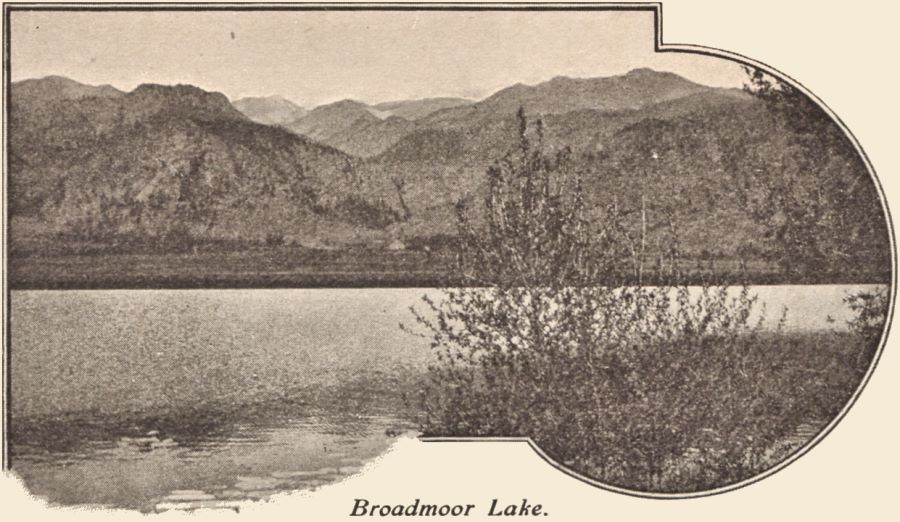 Lake Broadmoor
Lake Broadmoor
We also have Manitou, sparkling like a gem on the foot of the Peak, its marvelous soda, iron, sulphur and other mineral waters cheering the interior of the millions of Asia, Europe and other places for 25 cents, while here we can bathe in it for two bits.
It may not be improper to enquire right here where is another town of this size with nine millions stored away in bank deposits, and with a splendid new Y. M. C. A. building, with a brand new gothic court house, with a new Elk's Club building classical and beautiful, with a massive new red sandstone Scientific Hall, with a large, costly city hall about completed, a ravishing Carnegie Library building about to sprout, with a stylish and artistic government building ready to go up, all at one and the same time?
Show us the city that has a natural mixture of mortified granite and adobe, making the finest natural pavements ever dreamed of by mortal man? Where is it?
Point out the town with such splendid mansions, dwellings and cottages, with such a pleasing architectural variety, such lawns, such neatness, such broad, clean streets, decorated with such stately cottonwoods, with such running water in the gutters, such Red Devil auto-go wagons, such toppy turnouts, such splendid drives as we have here in this place.
I am loth to hurt the feelings of those who think it boastful to mention our wonderful array of exclusive attractions, but perhaps I may cautiously ask for the location of any other city that has a great gold camp attachment, but a few miles distant—a camp opened up, developed and operated largely by the city's citizens—which enriches the world to the tune of $20,000,000 per year in the yellow coin of the realm? There is no such place elsewhere. Can anyone imagine the sensation that would have resulted had Cripple Creek been discovered in the outskirts of Philadelphia, Pa.? Think of the hysterics that would still be going on back there, while here we are so used to such luxuries that we almost deem it impolite to mention them.
Speaking of enterprise, where is there a metropolis of our size where $25,000 could be as easily raised by residents to park the center of a street for a few blocks as was recently done on Cascade avenue?
Does anyone know of a community of 25,000 souls that has a more complete, modern and efficient street car plant and service than we have? Will not those who are so passionately fond of California please stand up and name the community?
Space forbids reference to any more of our unsurpassed advantages; however, it will do no harm to state that six railways have been made prosperous and happy by coming to Colorado Springs.
The fact that our city and county officials are not in jail, nor even indicted; that we have the best college in the West, and the best public schools in the world; that we have the most expensive telephone and electric light service on earth; that our nights are mild in winter and cool in summer, and the days delightful the year around; that our hotels are large, elegant, well victualed and free from extortion and other unpleasantness; that property is reasonable, and rents and taxes within the reach of all; that a whole mint of people have become ridiculously rich here, and like matters will not be mentioned lest I be charged with a desire to boom the town.
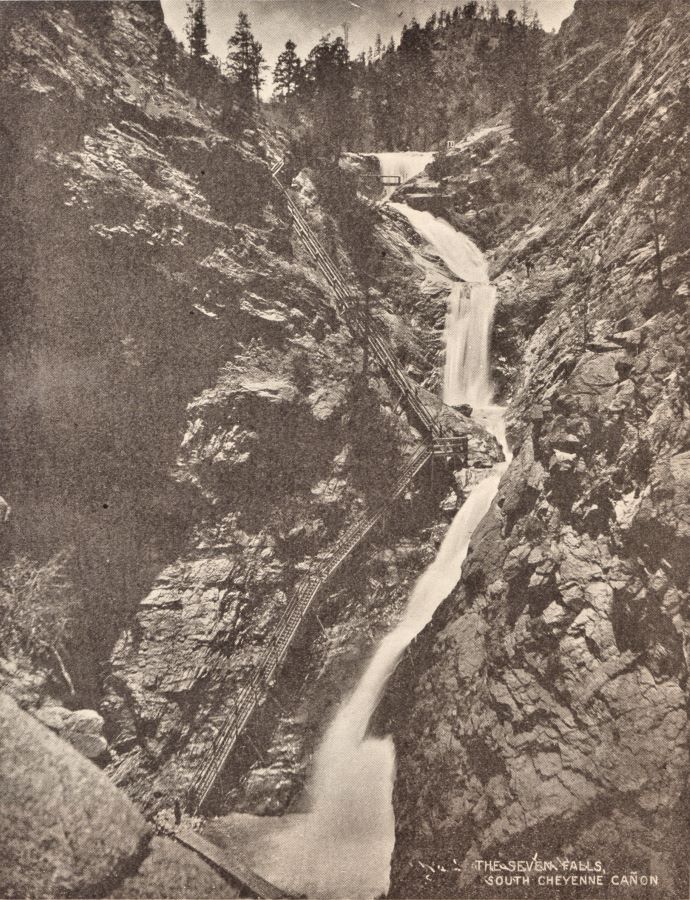
Seven Falls.
Suppose a stranger comes to this city, what will he find?
He will find the streets crowded with well-fed, well-dressed and well-satisfied people. Not a drunkard, a hobo or a disagreeable person in sight.
He will find that we have no saloons or other places in the city. He will find inebriety and crime so scant that our police hang their heads in shame when, in obedience to the law, they draw their pay.
If the visitor is of a pious turn of mind, he will find the finest array of churches and dominies he ever saw, and he will find righteousness prevailing night and day to a greater degree than anywhere he can go, here below.
If he loves amusements and athletics, we have them in abundance.
If he loves charming environments, we have Ivywild, Colorado City, Manitou and Denver close at hand.
If he dotes on science, literature or art, he will find a friendly atmosphere and several clubs, societies and intellectual combines that will be glad to have him come and dote with them.
If he be a criminal, he will find a warm reception and tidy, comfortable quarters.
If he loves politics, he will find it clean and decent here. No thick-necked, beetle-browed, pug-nosed, double-fisted political bosses with dyed moustaches in either party here. We would hang such a person on sight.
If he is a lady, he will find excellent society, and that he will be perfectly free from any annoyance on the streets at any time. No nasty saloons, no drunks or malodorous bums to shy around as he passes through the streets; no nothing but peace and decency everywhere.
He will find the air snappy and full of ginger, and the people active, hustling and full of fizz, whereas in California tenderfeet have to take several naps per day because of the drowse in the air.
If he is a cheerful and good-natured stranger he will be right at home, for we are almost all that way ourselves.
If he is a chronic fault-finder and loves to stand around on corners and snarl at everybody and everything, we have a small colony that will welcome him. More chronic growlers have been cured of this pestilential disease by the bracing atmosphere of Colorado Springs than the world dreams of. Those we now have are convalescing rapidly. They will soon be cured and their mental vision will become as clear as crystal.
If he is inclined to go into business he will have to look sharp for vacant stores, for there are none. He will find that this city has doubled in population during the past twelve years and that the general trend of business has had very few sags during that time. He will learn that when it has sagged we have, instead of snorting and gnashing our teeth, and calling the world to witness our annoyance, buckled to and kept things going until the situation eased up. He will also learn, if he looks into the matter, that when panic was throttling the commerce of the state and banks were closing their doors, Colorado Springs was the least affected of any city in the West, and that it has a business and financial strength that is astonishing to mankind.
If he be a lawyer or a doctor he will find excellent company, for no town in our class has a more efficient and brainy flock of attorneys and physicians than we have. All—or nearly all—of the pestiferous two-spots left town long ago.
After he has thought all these things over he will, if he is wise, turn to and become a citizen of the luckiest, most handsome, most healthful, best governed, most orderly and most prosperous community of which civilization boasts—the which is this same Colorado Springs.
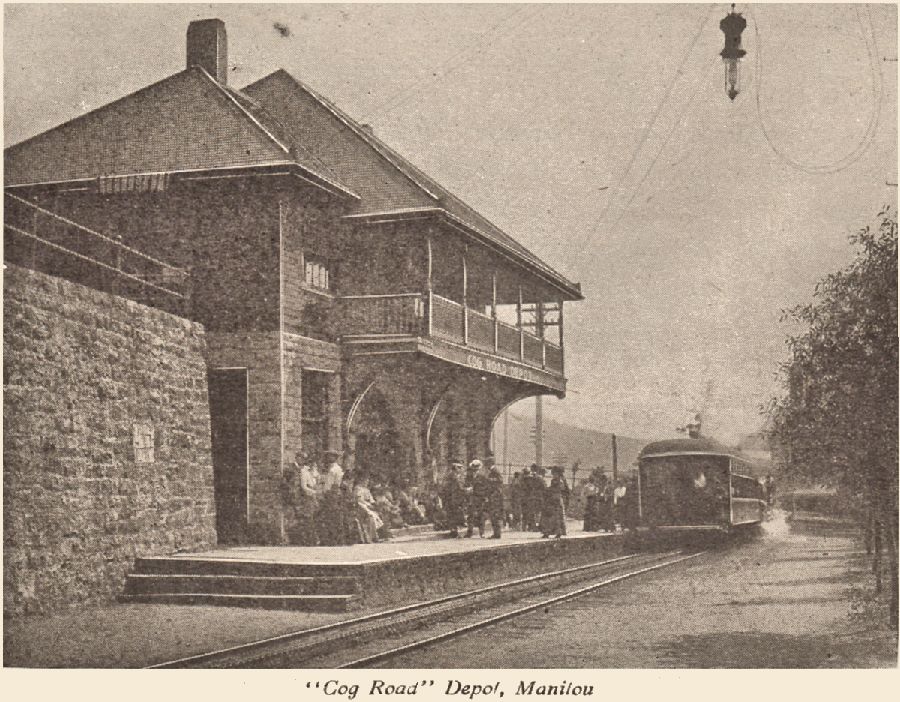 Looking at the Depot of the Pike's Peak Cog Rail
Looking at the Depot of the Pike's Peak Cog Rail
COLORADO'S one city which is a city all the year, but which has no other business than that of furnishing health and entertainment to visitors is Manitou.
Manitou is one of the oldest cities in the state. Its mineral springs, which are the equal in their medicinal properties of any in the country, were used by the Indians before the white man knew the trails across the plains. Situated as the city is, at the entrance to Ute Pass, it was always a favorite gathering spot for the tribes that inhabited the land before civilization encroached thus far upon their domain, and here they were wont to bring and heal their sufferers.
Five miles west of Colorado Springs, Manitou is the favorite stopping place for thousands of the tourist throng that annually visits Colorado. From Manitou, Colorado's most famous scenic attractions are most easily reached. The Garden of the God's, Pike's Peak, Glen Eyrie, Williams Canon and the famous resorts of Ute Pass are numbered among the attractions of this American Carlsbad, and the little city is one that, visited once, becomes a regular stopping place for the traveler who finds himself with time or the opportunity to include it in his itinerary.
-enhanced_wb.jpg) Looking at town across the Short Line where it crosses Poverty Gulch.
Looking at town across the Short Line where it crosses Poverty Gulch.
ONE quarter of the gold that is contributed by the United States to the wealth of the world annually comes out of Cripple Creek and the hills on which this thriving mining city is built. Cripple Creek is a romance; it is not a commonplace story. Yet it is not a romance, for it is real.
For twelve years men have been delving into the hills of Cripple Creek for gold, and each year has seen the wealth taken out in increasing quantities. During this total period the camp has added to the wealth of the world approximately $140,000,000. Little more than this need be said to tell the story of Cripple Creek. Its tonnage is about 600,000 tons annually.
In addition to its mines the city has a thoroughly equipped school system, its schools being graded to the highest standards reached in the state, and its citizens enter enthusiastically into whatever is for the best interests of Colorado as a whole.
Cripple Creek is a little south of due west from Colorado Springs. It is reached via "The Short Line," the trip skirting the south slope of Pike's Peak for forty-five miles, or by the Colorado Midland and Midland Terminal, which encircled the same peak via the north, the distance by this line being about sixty miles.
With the camp settled down to a steady production, its condition as to population, etc., also is settled. With the other cities of the gold district, including Victor, Goldfield, Altman, Independence, Elkton and Anaconda, who are but parts of a composite community, it has today about 25,000 people.
-enhanced_wb.jpg) Looking at town across hills south east of Victor.
Looking at town across hills south east of Victor.
TO write up the city of Victor would seem, at first glance, but to repeat a mention of its sister city, Cripple Creek, or, at best, to tell a very similar story.
This would be true were it not that the public which thinks it knows something about the Cripple Creek district fails almost utterly to appreciate how important a part of that district the city of Victor really is. Victor is the home of the bonanza gold producers of the district. The Portland, which has produced nearly $19,000,000, Stratton's Independence, with a record of $16,000,000, the Strong, with $8,500,000 to its credit, the Gold Coin, with more than $5,000,000 to show,—all these are Victor properties, while the Elkton, which has given its owners $5,000,000, is just outside the town.
Victor is a city of enterprising men. It has the highest membership in fraternal organizations of all Colorado cities except Denver, Colorado Springs and Pueblo, and has a social circle of which any city could well be proud.
in Colorado Mining
MUCH less than half a century ago a little yellow stream, guided by a pioneer's hand, began to trickle out of a gulch in Clear Creek county. It found its way to the sea of civilization, excited ambitions and won more gold seekers. More men came and more streams started. They have been coming ever since, and many have in one way or another, through personal efforts or the investment of capital, started metallic movements until today little rivers of bullion, yellow, white, red and other colors, are flowing from nearly every mountain county in the commonwealth. Such is Colorado from a mining point of view.
Forty-four years ago, George A. Jackson, an adventurous spirit, drove a pick into the gravel of Chicago gulch, today the site of Idaho Springs. He turned up a few specks of yellow metal, a few cents worth; a trivial incident in itself, but one that marked the birth of a new mineral empire. Today twenty regiments of men are tapping the rocks, and in response rivers of metal of various colors and myriad uses, is running from the state. Its worth for a year, for the year just ended, is about $50,000,000, a mere bagatelle, they tell us, to what it will be in another half century, or in half that time. Of the year's wealth half is of gold.
The past year has seen no great decrease in the flow. There was a period of contraction, when the miner ceased effort, but this is almost at end, and the pent up streams have risen anew and are coming with a rush that promises a flood in the ensuing year.
But Colorado broke another record in 1903, if the period of inactivity be taken into consideration. Most of the statisticians acquiesce to the claim. Gold is not so far behind its last race even under the conditions, silver forged ahead under the encouragement of a rising market while lead and copper, and particularly zinc, with the latter contribution from Leadville, set a pace that the old years, barring those of silver's supremacy, may never catch up with.
And it has not been the old mines alone that contributed so heavily. Many good outputs came from the youngsters, and in this connection it is timely to note the vast number of mineral births and the great number of mechanical cradles, magnificent machinery plants, that have been brought in and installed to rock along this new life.
In number of discoveries Cripple Creek unquestionably leads the state. It has advantages in the breadth and compactness of its field, facilities for search, and the number of its searchers. But in the installation of machinery it took a lesser place, as will any camp so elaborately equipped in the days of its growth. It was in the northern fields, Clear Creek, Gilpin and Boulder, in the south, the San Juan country and its many neighbors, in the mineral circle about Lake, that mechanical devices were drawn in so numerously during 1903. To the miner's mind, arriving machinery means the infusion of new blood, new strength and greater mining deeds, an infallible sign of approaching and continued prosperity. With the machinery came heavy investments of Eastern and Western money, notably of Western money, and from them fortunes are already beginning to flow back, and more are in prospect and are likely to be brought in during this and succeeding years.
Up in the northern and over in the western field tunnels are cutting mountains in twain, joining in magnificent thoroughfares the counties of Clear Creek and Gilpin, Lake and Park.
In the south land equally daring feats have been attempted and some accomplished, while in the whole mineral territory, throughout an area equal to the New England states, was it smoothed out, wherever a miner's steel touches rock veins are being ransacked for the ever increasing wealth that promises further renown for the Centennial state.
Some one said that they never make a strike in the San Juan. The strikes were made by Nature in great outcroppings leagues long and streets wide. Man has only to back up, load up and cart away. The saying almost fits. But some grand engineering was done to prepare for the loading, and some powerful plants built to reduce the load. The past year has been prolific of such development in the golden San Juan.
It used to be said that Colorado was loaded with experimental monuments. Between us—what they did say was "monumental failures," in referring to certain of our treatment plants. That expression used to be whispered. Half the counties had them, and a few still have them. Today Colorado is alive with monumental successes. This is due to the wisdom that experience taught. Once we were eager listeners to the tale of a process man; quick buyers of anything that promised gold, while we watched. Today the man with a process is in dangerous business, unless he arrives by recognized routes. Instead of building his mill and trying to make our ore fit it, as we too often did in the past, we take our ore to town and have a specialist prescribe a treatment.
Leadville and Cripple Creek furnish substantial evidence of our time-acquired wisdom. Both districts have ores, several kinds of them, that long resisted every dose given. It was mainly during the past year or two that the proper remedies were discovered. How successfully they are administered is convincingly testified to by the volume of wealth that is streaming today from hitherto idle and condemned acreages. Cripple Creek furnished a striking example. It has several hills of oxidized ore, the contents of which would hardly attract a Black Hills low grader. Someone measured the proper quantity of cyanide and other ingredients, and in consequence two-dollar profits are being taken from four-dollar ores. Two little tanks grew into half a dozen big ones, and today there are several plants throughout the camp that are manufacturing gold from oxidized rock.
The full importance of these demonstrations lies not alone in the metal these plants are producing, but in the possibilities they open for a vast mineralized territory mainly outside of what has been popularly termed the productive belt. The line has already been broken at several points, notably on the north, and invasions are well under way in other directions. There are miles of veins outside this, and belts that are filled with ore of low grade. They contain the gold, and patiently await man's discovery of a means for economical treatment. If achievements for the twelfth month entered equal those of the year passed, we will be breaking ore for profit in these sections before the century is six years old.
To record achievements, those of engineering, mechanics and reduction, for the year just ended, in any mining district of the state would be worthy the effort of a magazine staff and would fill a volume of formidable size. In this limited space mere reference can be made to but a few of the foremost.
Fond as we are of referring to Cripple Creek's magnificent output, it is doubtful if any figures can be presented, without conflicting with the mint returns, that will indicate a value in excess of $15,000,000. Labor differences and the water problem are responsible for the shrinkage, mainly the former, but despite these impediments dividends were paid and individual profits made that aggregate approximately $2,000,000, bringing the total profits of the field up to a sum approaching $33,000,000.
From a physical standpoint the year has had few peers. Not only were many unknown ore bodies opened and many more known bodies broadly exploited, but the success of the drainage tunnel makes possible the exploration of promising veins into great depths.
Notable among discoveries were those of the Gold Coin and Portland, while those made on a score of lesser mines are of scarcely less importance. On the Gold Coin two lost shoots were recovered, and a new one found, one being of great size, while on the Portland fifteen known bodies were cut at new points in one month's work. The Portland's ore reserves were vastly increased and the treasury fund doubled. Large productions were maintained by many old shippers, and several new ones added to the list. Besides this, several miles were added to the underground workings, work was started on several deep shafts, and the announcement made that a number of shafts will be deepened as soon as conditions are favorable.
Formerly it cost $10,000 a vertical foot to discharge the water of the Cripple Creek district. Even then the unwatering was rarely satisfactory and never permanent.
In the El Paso drainage tunnel a relief is provided that cost $80,000. The water level is falling at the rate of ten or twelve feet a month, and in the last month of drainage the cost of pumping, it may be seen, was heavily discounted. It is believed that other water channels will be cut as the bore advances, and add to the speed of the fall. Among the tunnel's early beneficiaries were the El Paso and other mines of Beacon hill, the Gold King, Moon-Anchor and others of Gold hill, the Mary McKinney and Elkton of Raven hill, the Gold Coin and others on Battle mountain, and the Last Dollar and many others on parts of Bull hill. At several of these mines return to the levels submerged for several years will soon be possible, while in not a few sinking may be resumed within a few months.
Two more developments of the year are the successful treatment of cyanide of potassium at mills operating in the district and the further cut in the grade of ores that may be shipped and profitably treated at valley mills. There were successes and failures with cyanide experiments at Cripple Creek. It was expensively learned that sulphide ores are not amenable to the process without roasting. It was demonstrated, so the operators declare, that the oxidized ores of Globe and Ironclad hills and of Copper mountain can be made to yield their gold solely by chemical means, almost wholly by cyanide, without the aid of costly roasting plants. The Sioux Falls and Cripple Creek and the Cripple Creek-Homestake companies, each with mills of fairly large capacity, claim to have saved a large percentage of values from ores of very low grade, as low as $2, and to have demonstrated the possibility of large profits.
It was but two or three years ago that complaint was heard of the little margins left on $18 and $20 ores shipped to valley mills. Today $8 and $10 ores are handled profitably. It hardly pays to mine $8 ore, but once at the surface, where it arrived with material of better grade, there is more money in sending it to the mills than in putting it on the dumps. On certain contracts a $5.75 rate is made for transportation and treatment. Where $10 ore occurs in a large body it can be profitably mined under this rate.